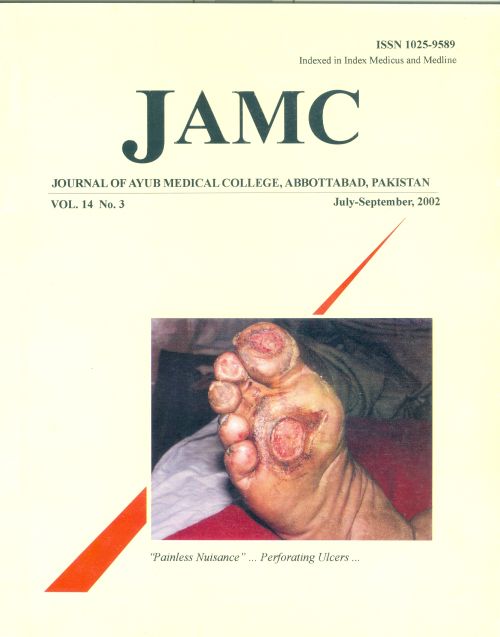A HOSPITAL BASED PRELIMINARY REPORT ON SLEEP DISORDERED BREATHING IN PAKISTANI POPULATION
Abstract
Background: Sleep Disordered Breathing is an important medical condition leading to significant morbidity and mortality. Western studies have shown its prevalence in middle age to be 9% in women and 24% in men. The aim of this study was to have a preliminary assessment on the frequency of Sleep Disordered Breathing in Pakistani subjects. Method:Patients attending a medical clinic were surveyed. A sleep questionnaire elicited information about snoring, witnessed apnoea, nocturnal choking and excessive daytime sleepiness. Data were recorded for age, height, collar size and weight. Epworth Sleepiness Scale was used to assess excessive daytime sleepiness. Statistical analysis was by chi square test, t-test and Fisher's exact test. A p-value less than 0.05 was considered significant. Results: A total of 123 subjects (M:F= 2:1) were included in the study. The frequency of snoring was found to be 46%. Snoring with apnoea was reported in 7% and snoring with apnoea and excessive daytime sleepiness in 3%. Snorers were more obese (p<0.001), older (p<0.003), with higher body mass index (p<0.001) and larger collar size (p<0.006) than non-snorers. Hypertension was more common in patients with sleep disordered breathing (35%) as compared to those without (16%). Conclusions: This is the first preliminary data on sleep disordered breathing from Pakistan that reflects that the prevalence is similar to that seen in the West. The risk factors and association with hypertension are also comparable.
Key Words: sleep disordered breathing; obstructive sleep apnoea; snoring; prevalence; Pakistan
References
Partinen M, Guilleminault C. Daytime sleepiness and vascular morbidity at seven year follow up in obstructive sleep apnea patients. Chest 1990; 97 (1): 27-32.
Whyte KF, Allen MB, Jeffery AA, Gould GA, Douglas NJ. Clinical features of the sleep apnea/hypopnea syndrome. Q J Med 1989; 72: 659-66.
Findley LJ, Wiess JW, Jabour ER. Drivers with untreated sleep apnea: a cause of death and serious injury. Arch Intern Med 1991; 151:1451-2.
Young T, Palta M, Dempsey J, Skatrud J, Weber S, Badr S. The occurrence of sleep disordered breathing among middle-aged adults. N Engl J Med 1993; 328:1230-5.
Johns MW. Sleepiness in different situations measured by the Epworth Sleepiness Scale. Sleep 1994; 17(8): 703-10.
Mary SM, Lam B, Lauder IJ, Tsang KWT, Chung K, Mok Y, Lam W. A community study of Sleep Disordered Breathing in Middle-aged Chinese Men in Hong Kong. Chest 2001; 119(1): 62-69.
Ng TP, Seow A, Tan WC. Prevalence of snoring and sleep related- breathing disorders in Chinese, Malay and Indian adults in Singapore. Eur Respir J 1998; 12:198-202.
Lindberg E, Gislason T. Clinical Review Article: Epidemiology of sleep-related obstructive breathing. Sleep Med Rev 2000;4(5): 411-33.
Davies RJO, Stradling JR. The epidemiology of sleep apnea. Thorax 1996;51: (suppl 2): s65-s70.
Lugaresi E, Cirignotta F, Coccagna G, Piana C. Some epidemiological data on snoring and cardiocirculatory disturbances. Sleep 1980; 3:221-24.
Stradling JR, Crosby JH. Predictors and prevalence of obstuctive sleep apnea and snoring in 1001 middle aged men. Thorax 1991; 46:85-90.
Hla KM, Young TB, Bidwell T, Palta M, Skatrud JB, Dempsey J. Sleep apnea and hypertension. A population based study. Ann Intern Med 1994;120:382-8.
Carlson JT, Hedner JA, Ejnell H, Peterson LE. High prevalence of hypertension in sleep apnea patients independent of obesity. Am J Respir Crit Care Med 1994; 150:72-7.
Fletcher EC. The relationship between systemic hypertension and obstructive sleep apnea: facts and theory. Am J Med 1995; 98:118-28.
Pawar R, Smith M, Wright JR, Strohl KP. Blood pressure regulation and sleep apnea. Cardiovascular Reviews and Report 1996.
Stradling JR. Sleep apnea and systemic hypertension. Thorax 1989; 44:984-89.
Hoffstein MD, Chan CK, Slutsky AS. Sleep apnea and systemic hypertension: a causal association review. Am J Med1991; 91: 190-96.
Wilcox I, Grunstein RR, Hedner JA, Doyle J, Collins FL, Fletcher PJ et al. Effects of nasal continuous positive airway pressure during sleep on 24-hour blood pressure in obstructive sleep apnea. Sleep 1993; 16(6): 539-44.
Downloads
How to Cite
Issue
Section
License
Journal of Ayub Medical College, Abbottabad is an OPEN ACCESS JOURNAL which means that all content is FREELY available without charge to all users whether registered with the journal or not. The work published by J Ayub Med Coll Abbottabad is licensed and distributed under the creative commons License CC BY ND Attribution-NoDerivs. Material printed in this journal is OPEN to access, and are FREE for use in academic and research work with proper citation. J Ayub Med Coll Abbottabad accepts only original material for publication with the understanding that except for abstracts, no part of the data has been published or will be submitted for publication elsewhere before appearing in J Ayub Med Coll Abbottabad. The Editorial Board of J Ayub Med Coll Abbottabad makes every effort to ensure the accuracy and authenticity of material printed in J Ayub Med Coll Abbottabad. However, conclusions and statements expressed are views of the authors and do not reflect the opinion/policy of J Ayub Med Coll Abbottabad or the Editorial Board.
USERS are allowed to read, download, copy, distribute, print, search, or link to the full texts of the articles, or use them for any other lawful purpose, without asking prior permission from the publisher or the author. This is in accordance with the BOAI definition of open access.
AUTHORS retain the rights of free downloading/unlimited e-print of full text and sharing/disseminating the article without any restriction, by any means including twitter, scholarly collaboration networks such as ResearchGate, Academia.eu, and social media sites such as Twitter, LinkedIn, Google Scholar and any other professional or academic networking site.










